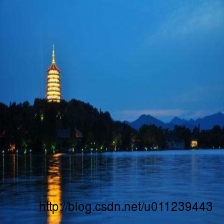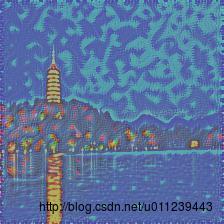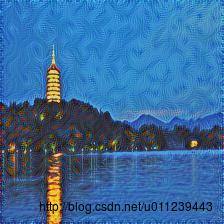TensorFlow实战——CNN(VGGNet19)——图像风格转化
Posted 小爷毛毛(卓寿杰)
tags:
篇首语:本文由小常识网(cha138.com)小编为大家整理,主要介绍了TensorFlow实战——CNN(VGGNet19)——图像风格转化相关的知识,希望对你有一定的参考价值。
http://blog.csdn.net/u011239443/article/details/73721903
这次我们要做一件比较有趣的事——讲图像风格转化。
如何将一张杭州西湖图片:

将其风格转化为和梵高的《星夜》一样具有鲜明艺术的风格呢?

先给出完整的代码:https://github.com/xiaoyesoso/TensorFlowinAction/blob/master/InActionB2/chapter4/tranImage.py
接下来我们来讲解它。
图像数据
if __name__ == '__main__':
style = Image.open('star.jpg')
style = np.array(style).astype(np.float32) - 128.0
content = Image.open('me.jpg')
content = np.array(content).astype(np.float32) - 128.0
stylize(style,content,0.5,500)
上述style读取的是《星夜》,将其转为浮点数组,并且减去128.0,这样就以0为中心,可以加快收敛。content读取的是《西湖》,操作相同。
要注意的是,style,content图片大小要相同。我在之前用“美图秀秀”将《星夜》和《西湖》的大小转为来
224
×
224
224×224
224×224。
print(content.shape)
print(style.shape)
可见:
(224, 224, 3)
(224, 224, 3)
风格转化
def stylize(style_image,content_image,learning_rate=0.1,epochs=500):
# 结果图片
target = tf.Variable(tf.random_normal(content_image.shape),dtype=tf.float32)
style_input = tf.constant(style_image,dtype=tf.float32)
content_input = tf.constant(content_image, dtype=tf.float32)
cost = loss_function(style_input,content_input,target)
train_op = tf.train.AdamOptimizer(learning_rate).minimize(cost)
with tf.Session(config=tf.ConfigProto(log_device_placement=True)) as sess:
tf.initialize_all_variables().run()
for i in range(epochs):
_,loss,target_image = sess.run([train_op,cost,target])
print("iter:%d,loss:%.9f" % (i, loss))
if (i+1) % 100 == 0:
image = np.clip(target_image + 128,0,255).astype(np.uint8)
Image.fromarray(image).save("./neural_me_%d.jpg" % (i + 1))
这里比较有趣的是,以前我们通常调优的是参数矩阵,然后配合测试数据预测出结果。而这边,我们没有测试数据,而所要调优的target矩阵,就是我们要得结果。
VGGNet19模型
VGGNet模型:

要注意的是,在这里我们并没有想试图训练VGGNet19模型,我们只是想获得图片在VGGNet19模型中的某些隐藏层上的特征矩阵。所以我们这里使用已经训练好的VGGNet19模型的参数,下载地址:http://www.vlfeat.org/matconvnet/models/beta16/imagenet-vgg-verydeep-19.mat
然后只需要加载它据可以了:
_vgg_params = None
def vgg_params():
global _vgg_params
if _vgg_params is None:
_vgg_params = sio.loadmat('imagenet-vgg-verydeep-19.mat')
return _vgg_params
def vgg19(input_image):
layers = (
'conv1_1', 'relu1_1', 'conv1_2', 'relu1_2', 'pool1',
'conv2_1', 'relu2_1', 'conv2_2', 'relu2_2', 'pool2',
'conv3_1', 'relu3_1', 'conv3_2', 'relu3_2', 'conv3_3', 'relu3_3', 'conv3_4', 'relu3_4','pool3',
'conv4_1', 'relu4_1', 'conv4_2', 'relu4_2', 'conv4_3', 'relu4_3', 'conv4_4', 'relu4_4', 'pool4',
'conv5_1', 'relu5_1', 'conv5_2', 'relu5_2', 'conv5_3', 'relu5_3', 'conv5_4', 'relu5_4', 'pool5'
)
weights = vgg_params()['layers'][0]
net = input_image
network =
for i,name in enumerate(layers):
layer_type = name[:4]
# 若是卷积层
if layer_type == 'conv':
kernels,bias = weights[i][0][0][0][0]
# 由于 imagenet-vgg-verydeep-19.mat 中的参数矩阵和我们定义的长宽位置颠倒了,所以需要交换
kernels = np.transpose(kernels,(1,0,2,3))
conv = tf.nn.conv2d(net,tf.constant(kernels),strides=(1,1,1,1),padding='SAME',name=name)
net = tf.nn.bias_add(conv,bias.reshape(-1))
net = tf.nn.relu(net)
# 若是池化层
elif layer_type == 'pool':
net = tf.nn.max_pool(net,ksize=(1,2,2,1),strides=(1,2,2,1),padding='SAME')
# 将隐藏层加入到集合中
# 若为`激活函数`直接加入集合
network[name] = net
return network
我们将weights打印出来看看:
print(weights.shape)
得到:
(43,)
可知imagenet-vgg-verydeep-19.mat还可以支持比VGGNet19更多层的VGGNet模型。
若是卷积层,如conv1_1:
print(weights[0][0][0][0][0])
得到的是参数矩阵和偏置:
[ array([[[[ 0.39416704, -0.08419707, -0.03631314, ..., -0.10720515,
-0.03804016, 0.04690642],
[ 0.46418372, 0.03355668, 0.10245045, ..., -0.06945956,
-0.04020201, 0.04048637],
[ 0.34119523, 0.09563112, 0.0177449 , ..., -0.11436455,
-0.05099866, -0.00299793]],
[[ 0.37740308, -0.07876257, -0.04775979, ..., -0.11827433,
-0.19008617, -0.01889699],
[ 0.41810837, 0.05260524, 0.09755926, ..., -0.09385028,
-0.20492788, -0.0573062 ],
[ 0.33999205, 0.13363543, 0.02129423, ..., -0.13025227,
-0.16508926, -0.06969624]],
[[-0.04594866, -0.11583115, -0.14462094, ..., -0.12290562,
-0.35782176, -0.27979308],
[-0.04806903, -0.00658076, -0.02234544, ..., -0.0878844 ,
-0.3915486 , -0.34632796],
[-0.04484424, 0.06471398, -0.07631404, ..., -0.12629718,
-0.29905206, -0.28253639]]],
[[[ 0.2671299 , -0.07969447, 0.05988706, ..., -0.09225675,
0.31764674, 0.42209673],
[ 0.30511212, 0.05677647, 0.21688674, ..., -0.06828708,
0.3440761 , 0.44033417],
[ 0.23215917, 0.13365699, 0.12134422, ..., -0.1063385 ,
0.28406844, 0.35949969]],
[[ 0.09986369, -0.06240906, 0.07442063, ..., -0.02214639,
0.25912452, 0.42349899],
[ 0.10385381, 0.08851637, 0.2392226 , ..., -0.01210995,
0.27064082, 0.40848857],
[ 0.08978214, 0.18505956, 0.15264879, ..., -0.04266965,
0.25779948, 0.35873157]],
[[-0.34100872, -0.13399366, -0.11510294, ..., -0.11911335,
-0.23109646, -0.19202407],
[-0.37314063, -0.00698938, 0.02153259, ..., -0.09827439,
-0.2535741 , -0.25541356],
[-0.30331427, 0.08002605, -0.03926321, ..., -0.12958746,
-0.19778992, -0.21510386]]],
[[[-0.07573577, -0.07806503, -0.03540679, ..., -0.1208065 ,
0.20088433, 0.09790061],
[-0.07646758, 0.03879711, 0.09974211, ..., -0.08732687,
0.2247974 , 0.10158388],
[-0.07260918, 0.10084777, 0.01313597, ..., -0.12594968,
0.14647409, 0.05009392]],
[[-0.28034249, -0.07094654, -0.0387974 , ..., -0.08843154,
0.18996507, 0.07766484],
[-0.31070709, 0.06031388, 0.10412455, ..., -0.06832542,
0.20279962, 0.05222717],
[-0.246675 , 0.1414054 , 0.02605635, ..., -0.10128672,
0.16340195, 0.02832468]],
[[-0.41602272, -0.11491341, -0.14672887, ..., -0.13079506,
-0.1379628 , -0.26588449],
[-0.46453714, -0.00576723, -0.02660675, ..., -0.10017379,
-0.15603794, -0.32566148],
[-0.33683276, 0.06601517, -0.08144748, ..., -0.13460518,
-0.1342358 , -0.27096185]]]], dtype=float32)
array([[ 0.73017758, 0.06493629, 0.03428847, 0.8260386 , 0.2578029 ,
0.54867655, -0.01243854, 0.34789944, 0.55108708, 0.06297145,
0.60699058, 0.26703122, 0.649414 , 0.17073655, 0.47723091,
0.38250586, 0.46373144, 0.21496128, 0.46911287, 0.23825859,
0.47519219, 0.70606434, 0.27007523, 0.68552732, 0.03216552,
0.60252881, 0.35034859, 0.446798 , 0.77326518, 0.58191687,
0.39083108, 1.75193536, 0.66117406, 0.30213955, 0.53059655,
0.67737472, 0.33273223, 0.49127793, 0.26548928, 0.18805602,
0.07412001, 1.10810876, 0.28224325, 0.86755145, 0.19422948,
0.810332 , 0.36062282, 0.50720042, 0.42472315, 0.49632648,
0.15117475, 0.79454446, 0.33494323, 0.47283995, 0.41552398,
0.08496041, 0.37947032, 0.60067391, 0.47174454, 0.81309211,
0.45521152, 1.08920074, 0.47757268, 0.4072122 ]], dtype=float32)]
若是激活函数,如relu1_1:
print(weights[1][0][0][0][0])
输出:
relu
若是池化层,如pool1:
print(weights[4][0][0][0][0])
输出:
pool1
损失函数
STYLE_WEIGHT = 1
CONTENT_WEIGHT = 1
STYLE_LAYERS = ['relu1_2','relu2_2','relu3_2']
CONTENT_LAYERS = ['relu1_2']
def loss_function(style_image,content_image,target_image):
style_features = vgg19([style_image])
content_features = vgg19([content_image])
target_features = vgg19([target_image])
loss = 0.0
for layer in CONTENT_LAYERS:
loss += CONTENT_WEIGHT * content_loss(target_features[layer],content_features[layer])
for layer in STYLE_LAYERS:
loss += STYLE_WEIGHT * style_loss(target_features[layer],style_features[layer])
return loss
可以看到权重STYLE_WEIGHT和CONTENT_WEIGHT可以控制优化更
取趋于风格还是趋于内容。而STYLE_LAYERS的层数越多,就能挖掘出《星夜》越多样的风格特征,而CONTENT_LAYERS中的越深的掩藏层得到的特征越抽象。
建议STYLE_LAYERS中的层数尽可能的多,这样更加能挖掘出《星夜》风格特征。当然层数多了或者深了,所需要的迭代次数需要很大才能得到比较好的效果。由于机子不给力,我只迭代了500轮,只选了三个隐藏层'relu1_2','relu2_2','relu3_2'。而CONTENT_LAYERS中的隐藏层的越浅就表达了目标图中原内容就越具像。
- 内容损失函数很简单,就是特征值误差:
def content_loss(target_features,content_features):
_,height,width,channel = map(lambda i:i.value,content_features.get_shape())
content_size = height * width * channel
return tf.nn.l2_loss(target_features - content_features) / content_size
- 风格损失函数。我们现将三维特征矩阵
(-1,channel)重塑为二维矩阵,即一行代表一个特征值,三列分别是RGB。使用其格拉姆矩阵( A T A A^TA ATA)误差作为返回结果。
def style_loss(target_features,style_features):
_,height,width,channel = map(lambda i:i.value,target_features.get_shape())
size = height * width * channel
target_features = tf.reshape(target_features,(-1,channel))
target_gram = tf.matmul(tf.transpose(target_features),target_features) / size
style_features = tf.reshape(style_features,(-1,channel))
style_gram = tf.matmul(tf.transpose(style_features),style_features) / size
return tf.nn.l2_loss(target_gram - style_gram) / size
结果图
好啦,接下来看看我们的作品吧。
迭代100轮:

迭代200轮:

迭代300轮:

迭代400轮:

迭代500轮:

可见结果图的内容的原来越清晰的,但是过于清晰反而不具有艺术感,可以适当加深加多CONTENT_LAYERS中的隐藏层。注意图片的右上部分,也可以发现越发具有类似于《星夜》的旋转的风格纹路细节。
赠送一只胖子~
原:

100:

200:

300:

400:

500:

以上是关于TensorFlow实战——CNN(VGGNet19)——图像风格转化的主要内容,如果未能解决你的问题,请参考以下文章
4.1 CNN卷积神经网络概述tensorflow实现——python实战
TensorFlow2深度学习实战(十七):目标检测算法 Faster R-CNN 实战